Effective Temperature Control in Your Whirlpool Refrigerator: A Comprehensive Guide
If there's one thing that makes a Whirlpool refrigerator indispensable, it's the confidence that your perishables remain crisp and fresh. However, this relies heavily on understanding and managing the temperature control settings. Many users find themselves puzzled over the exact location and optimal adjustments needed for efficient temperature control. Dive into this all-encompassing guide to unravel the mysteries of your Whirlpool refrigerator’s temperature settings and ensure your groceries are stored perfectly every time.
Unveiling the Temperature Control Location
Where exactly is the temperature control on a Whirlpool refrigerator located? For most Whirlpool models, the controls are situated prominently for user convenience:
- Interior Upper Compartment: Typically, in the upper area inside the fridge section, often centralized or slightly to the side.
- Panel Interface: Some models boast an electronic interface located outside on the refrigerator door, offering digital controls.
- Freezer Section: Occasionally, especially in top-freezer models, the control knobs might be within the freezer.
Variations in Models
Understanding your specific model is key. Each model may have slight variations, so referring to the user manual or checking Whirlpool’s online resources can provide guidance tailored to your unit. Key Tip: Always familiarize yourself with the appliance's instruction manual as modern models often integrate intuitive designs and electronic touchpads.
How to Adjust Temperature Settings Correctly
Why is managing temperature crucial? Proper temperature control maintains food quality, prevents spoilage, and promotes energy efficiency.
Basic Steps to Adjust:
- Identify the Controls: Start by locating the control dials or electronic panel within your refrigerator.
- Default Settings: Most units are shipped with pre-set optimal settings noted as 37°F for the refrigerator compartment and 0°F for the freezer.
- Adjust as Needed:
- Manual Dials: Simply turn the dial clockwise or counterclockwise to achieve desired settings.
- Digital Panels: Use the up and down arrows to select the precise temperature, or toggle through options if programmable.
Tips for Adjustment
- Ambient Factors: Consider external factors like ambient room temperature and fridge load which might necessitate adjustments.
- Monitor Changes: Post-adjustment, allow 24 hours for the temperature to stabilize and verify with a fridge thermometer.
Related Considerations and Common Issues
While temperature adjustments might seem straightforward, several additional factors can impact performance:
Food Placement
Positioning plays a huge role in efficient cooling:
- Air Vents: Avoid blocking air vents for optimal air circulation.
- Shelving: Store raw meats on the lower shelves to prevent contamination.
- Door Compartments: Use these for condiments, as they're slightly warmer.
Signs of Unequal Cooling
Recognize the signs that indicate improper cooling:
- Frost Accumulation: Regular buildup signifies settings that may be too low.
- Premature Spoiling: Indicates that temperatures aren’t sufficiently cold.
- Internal Condensation: Might result from blocked doors or ineffective seals.
Troubleshooting Basic Temperature Concerns
If adjustments don’t seem to work, consider these practical solutions:
- Check Seals: Ensure gaskets are clean and airtight; compromised seals alter efficiency.
- Clean Coils: Periodically clean compressor coils to enhance cooling performance.
- Avoid Overloading: Excessive items restrict airflow and can hamper temperature settings.
Enhancing Refrigerator Efficiency
Optimizing temperature settings is essential for appliance efficiency. Here’s how you can improve overall performance:
Efficient Practices
- Consistent Organization: Maintain an organized interior to ensure proper air circulation.
- Regular Maintenance: Vacuum coils and check door seals for gaps regularly.
- Upgrade Awareness: Be aware that older models might not have the precision control available in newer units.
Embrace Energy-saving Practices
Energy conservation not only benefits the environment but could also minimize costs:
- Temperature Stability: Avoid frequently leaving the fridge open; temperature recovery takes energy.
- Positioning: Keep your refrigerator away from heat sources like ovens or direct sunlight.
Quick Summary Tips 💡
- 🔍 Keep It Simple: Always start with default settings and adjust as necessary.
- 📊 Monitor Regularly: Use a fridge thermometer to double-check internal temperatures.
- 🍳 Mindful Placement: Organize foods to enhance airflow and efficiency.
- 🔄 Regular Checkups: Keep your appliance in peak condition with regular maintenance checks.
Adapting to Modern Refrigeration Trends
Whirlpool continues to evolve with technology, making refrigerators more equipped with innovative temperature mechanisms. Understanding these advancements can provide better food safety and storage solutions.
Smart Refrigerator Capabilities
Modern refrigerators are increasingly becoming ‘smart’ with smart sensor technology and WIFI connectivity:
- Remote Monitoring: Adjust settings directly from a smartphone app.
- Eco-settings: Some models have eco-modes to maintain energy efficiency when usage is low.
Embracing Innovations
- Precision Cooling: Dedicated compartments with different settings for varying food types.
- Adaptive Defrosting: Sensing when defrost cycles are required to minimize energy usage.
These trends advocate a holistic look at refrigerator management, considering factors beyond mere temperature tweaks, making appliances smarter and user-friendly.
Navigating the complexities of a Whirlpool refrigerator's temperature control might initially seem daunting, yet a well-informed approach pays off in both functionality and energy savings. Understanding these parameters not only preserves food quality but also amplifies appliance longevity. Whether you're making routine adjustments or tapping into the multifaceted features of modern models, always ensure that your Whirlpool refrigerator works in tandem with your lifestyle needs.
